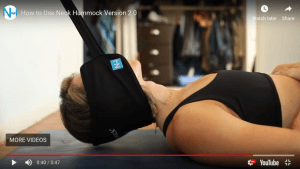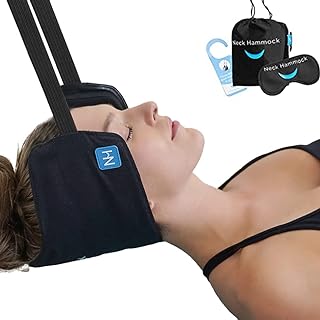Neck Hammock Cervical Traction Device
I am reviewing the "Neck Hammock" cervical traction device separately from other cervical traction devices as this product is one that has gotten a lot of attention lately - probably due to being discussed on the Dr. Oz show - and I have had quite a few patients ask me about it. As with the other traction devices I have reviewed, I will give some background information that may be helpful in understanding the effects of cervical traction in general and type of therapeutic effect this specific Neck Hammock device may have.
The bones in the neck (cervical vertebrae) are separated by softer cartilaginous material (cervical discs) to allow movement and flexibility in the spine. In the upright position, each cervical disc, and associate spinal joints, receive some degree of compressive force from the weight of the head along with each spinal vertebra and surrounding body structures above the spinal segment in question. Combined with the fact that the lower cervical spinal segments have greater freedom of movement compared to the upper thoracic segments (the top part of the upper back which is limited in it's ability to move due to the upper portion of the ribcage being attached to them), the forces received by the lower cervical discs make them a common spinal region for problems such as disc degeneration and disc herniation as well as osteoarthritic changes in the associated spinal joints. To counteract some of the effects of daily compressive forces, the oppositve force - traction - may be applied with a beneficial effect in certain cases. Traction forces have the effect of dropping some of the pressure within each spinal disc as well as reducing the pressure on spinal joints. This may help improve circulation to the disc (this can be compared to nutrients being "pulled" from the circulation of the bone above and below the disc) as well as potentially allowing "bulging discs" (some types of disc herniation) to be reduced. In many cases, the decreased pressure on other spinal structures can also help relieve pain and reduce muscle spasm. So can the Neck Hammock achieve some of the beneficial effects of cervical traction? Well....sometimes! Let's look at when those times may be.
1). The person is able to tolerate the position of treatment (see above video). Younger individuals usually have no problems tolerating lying facing up with this device making contact with the neck and exerting a mild traction force. However, certain individuals such as people with fibromyalgia or those with severe osteoarthritis in the spine may not be able to tolerate this position.
2). The individual does not have a severe disc herniation. As counterintuitive as this may seem, a large disc herniation that pinches a nerve as it comes out between two spinal segments may not respond well to this device. How is this possible? After all, doesn't traction pull the joints apart? The reason is that, unless the position of the spine is very precise in this particular instance, over-extension of the spine can close off the space behind the disc and pinch the nerve at that level, even if the pressure on the disc decreases, while too much flexion can allow the disc to bulge further into that space.
3). The person does not have an acute cervical sprain or strain. Traction under this circumstance may further aggravate the injury leading to more inflammation, pain, spasm or even further injuring recently damaged tissues.
4). The person doesn't have spinal instability or hypermobility to spinal segments. Obviously this device should not be used to treat pain associated with a cervical fracture but how about someone with generally loose ligaments, a lot of flexibility and constant "popping" in their neck? In a case like this, even though such a person may find temporary relief with this device, it will probably not be a great long term option as continued stretching of already loose ligaments will likely further contribute to spinal instability and cause muscles to stay tighter than normal (hypertonicity) to maintain some degree of stability.
5). The person doesn't have an underlying condition that is a contraindication to traction in general such as rheumatoid arthritis, tumors, osteomyelitis or other conditions in which there may be underlying structural or pathological lesions. Talk to your qualified health care provider if you have any doubt about your specific case.
So, bottom line, if the above criteria are met, it is my opinion that the neck hammock cervical traction device can be a useful product for some people to help relieve daily tension and neck pain. However, as everybody is different and every BODY is different, I recommend you discuss the use of this product with your qualified health care provider to make sure it is right for you. You may also wish to read what others say about this device by clicking on the amazon link above to see user reviews before making your decision.


